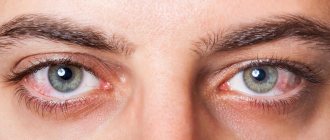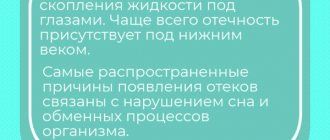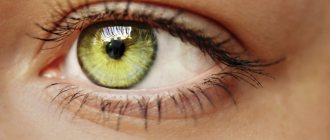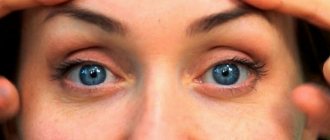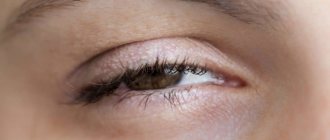Causes
Insomnia
Sleep disorders are accompanied by stress at home or at work, various diseases of the internal organs or a disorder of the nervous system. Systematic lack of sleep leads to cephalalgia, nausea, and loss of appetite.
After several days of insomnia, a person begins to experience mental disorders, impaired memory and attention, irritability, and weakness.
Overwork
When overworked, cephalgia is usually localized in the temples and frontal part, the pain radiates to the eyes. It occurs due to the accumulation of undigested glucose products in the brain tissue.
This leads to swelling and puts pressure on pain receptors located in the vessels. From here the pain spreads to the temples and eyes.
Altitude sickness
As altitude increases, atmospheric pressure drops, and as it decreases, the partial pressure of oxygen in the air mixture decreases. Up to an altitude of 4000 m, the body independently compensates for its lack; this happens due to rapid breathing and an increase in the volume of inhaled air.
When a person rises higher, there is a severe lack of oxygen. This is called mountain sickness, which can lead to cephalalgia, soreness in the eyes and muscles, and joints begin to ache. Nausea and vomiting often occur.
Air travel
The pain is caused by changes in altitude, disruption of the circadian rhythm, or contact with irritants on an airplane. May affect the ear and brow nerves.
Severe changes in pressure lead to rupture of blood vessels or the eardrum, causing severe pain.
Dental diseases
Dental diseases can cause pain in the orbit or under the eyes. It goes into the eye. Most often, the organs of vision and teeth are not connected to each other, but during purulent processes, the contents spread to any area, causing inflammatory processes, hence the characteristic signs.
Meningitis
The pain is more pronounced with purulent meningitis. The symptom may be accompanied by vomiting and nausea. With light and sound loads, cephalalgia intensifies, it increases with palpation of the eyeballs and radiates into the orbit.
Migraine
This is a lot of pain. Manifested by sensitivity to light, nausea, vomiting, dizziness, blurred vision and pain in and behind the eyes.
Migraine lasts up to several days. There is an eye type of the disease, when the main complaints are related to changes in vision.
Trigeminal neuralgia
With this condition, headaches vary in duration and intensity. During the next attack, severe salivation and lacrimation occurs, the face turns pale or red.
Usually the symptom is localized in the forehead, cheeks, jaws when talking and chewing. There is no pain in the eye area, but when severe it radiates into the orbit.
Glaucoma
Cephalgia and pain in the eye are characteristic signs of glaucoma. Sometimes the visual organ does not bother, which makes diagnosing the disease much more difficult.
Cephalgia appears due to irritation by a light source, overwork, and increased blood pressure. When glaucoma is advanced and bilateral in nature, it spreads to the parietal and frontal zone.
Sarcoidosis
More than half of patients with this diagnosis experience eye problems, ranging from dryness to inflammation. When the optic nerve deteriorates, the pain is localized in the area of the orbit and organs of vision, and a feeling of pressure appears in the temples.
Shingles
Characterized by the appearance of skin symptoms. The pain associated with the pathology is relatively mild and is more often observed at night or during rest. Rarely localized in the temporal region.
Temporal arteritis
Inflammation of the temporal artery leads to damage to the optic organ, leading to the development of iritis and conjunctivitis. The disease is accompanied by severe cephalalgia, insomnia, redness of the conjunctiva and increased body temperature.
Cluster type headache
This type of pain is similar to a migraine. It is burning, boring, and often has a seasonal dependence. Cephalgia is unilateral. Most often manifests itself in the temporal lobe and orbit.
Cluster-type cephalgia is accompanied by nasal congestion, redness of the face, swelling of the eyelids and profuse lacrimation.
Tumor of the eye orbit
A benign neoplasm causes not only blurred vision, but the appearance of pain in the affected area and half of the head corresponding to the location of the tumor.
Cavernous hemanginoma of the eye, due to elongation and incorrect position at the apex of the orbit, causes a pressing sensation that extends to the corresponding half of the head.
Neuroma is localized in the area of the optic nerve. In the affected orbit, the patient experiences pain that radiates to the temple, there is partial drooping of the eyelid and blurred vision.
A malignant tumor of the ocular orbit is characterized by constant pain. Strong pressure is felt on the vessels and nerve bundles, the eye is deformed, and the cornea is destroyed.
In the case of the development of cancer of the lacrimal gland, discomfort increases very quickly, and deformation of the eye is observed. During the examination, patients give the doctor a description of the unpleasant sensations, paying attention to early pain in the corresponding half of the head. Optic nerve atrophy is observed when the tumor grows into the cranial cavity.
Orbital tumors
Diagnostics
Headache in the temples and eyes is a reason to see a therapist. The doctor will take a medical history, find out how long the patient has been bothered by the symptom, and give a referral to other specialists.
To find out the cause, a set of diagnostic measures are taken:
- MRI can detect neurological pathologies associated with damage to the nerve structures of the brain and spinal cord. Magnetic resonance imaging allows you to clearly see soft tissue. The procedure lasts 30 minutes.
- used as a screening test for primary cephalgia, head injury without loss of consciousness and fainting.
- Examination of the fundus is carried out using an electric ophthalmoscope, a Vodovozov ophthalmochromoscope and a large non-reflex BO ophthalmoscope.
- Angiography of arterial vessels in the area of the temples, eyes and meninges is carried out to study their condition, blood flow and the extent of the pathological process.
Sometimes it is necessary to undergo laboratory tests to identify the causative agent of the infection. A general blood test is required for meningitis, sarcoidosis, herpes zoster, tumors, and viral diseases.
Shingles
The herpes virus affects the trigeminal nerve in older people and deforms the lower or upper eyelid. The pathogen can be transmitted by moving along nerve fibers to the mucous membrane of the eyes. The patient feels pain in one eye, during an exacerbation he feels pulsation, tension, as if a sharp arrow is piercing the brain.
A sharp increase in discomfort occurs when a person looks at a bright light. Daily fluctuations in discomfort are often pronounced, and hypertension is observed in the affected eye.
Diseases transmitted by the herpes virus require the use of antibacterial therapy during the development of a secondary infection. The ocular form of lichen leads to paralysis of the second cranial nerve and constant pain as a result of the development of anterior uveitis.
The disease progresses, and remission often occurs. Eye damage is found in half of patients with herpes zoster. To prevent vision loss, timely treatment is necessary.
Herpes zoster (shingles)
Treatment
A headache does not come on its own; it indicates serious illnesses that significantly worsen a person’s quality of life. Treatment of cephalalgia depends on the cause that provoked its appearance:
- Insomnia is treated with complex measures. Take a walk before going to bed, don’t watch TV an hour before bedtime, get up and go to bed at the same time, don’t drink alcohol at night, forget about coffee, don’t overeat. If necessary, sedatives and medications to help you sleep are prescribed.
- Overwork is best relieved by sleep and long rest. For severe pain, take Analgin and Citramon.
- Meningitis is treated with Ceftriaxone, Cefotaxime. This is a dangerous disease, so therapy is carried out in a hospital setting.
- Migraine is treated with analgesics, anti-inflammatory drugs, ergots and triptans. For frequent attacks, acupuncture, acupressure, and hydrotherapy are prescribed.
- Trigeminal neuralgia. Traditional remedies do not work; it is necessary to take a course of medications if the cause is microorganisms. If the nerve is pinched, a course of physiotherapy is prescribed in conjunction with a massage of the back of the head and neck.
- For the treatment of glaucoma, special drops are used that lower intraocular pressure. The disease is treated with mummy, leeches, and special physical exercises.
- Sarcoidosis is not usually treated. Thanks to the strengthening of the immune system, inflammatory foci resolve on their own.
- If shingles develops, the patient is sent to the hospital. Therapy is aimed at preventing the development, reducing burning and itching, pain and inflammation. Treatment is carried out simultaneously by several doctors, usually an infectious disease specialist and a neurologist. Cephalgia goes away when you receive the first doses of drugs.
- For cluster cephalgia, analgesics, antispasmodics and steroids are taken. For nasal congestion, drops or sprays are prescribed to ease breathing.
- Temporal arteritis is treated with corticosteroids, drugs to dilate blood vessels. To reduce cephalgia and pain in the eyes, analgesics and antispasmodics are prescribed.
When is throbbing pain localized in the temples and back of the head especially dangerous?
In some cases, this phenomenon requires immediate consultation with a specialist, and the sooner you visit him, the greater the chance of stopping the progression of the disease at the earliest stage of the disease.
You need to visit a doctor in the following cases:
- pain increases with increasing load;
- lasts for several hours;
- discomfort is observed for several days, and it does not have to be intense;
- unpleasant sensations arise from the very morning, while the person has not yet gotten out of bed;
- accompanied by tinnitus, congestion, darkening of the eyes, nausea/vomiting, numbness of the limbs, and impaired coordination of movements.
When pulsation is accompanied by a sharp increase in blood pressure, you need to call an ambulance, as there is a high probability of a hypertensive crisis.
Throbbing pain in the left or right temple is always only a symptom of some pathology or the body’s response to an incorrect lifestyle, poorly organized work process or excessive psycho-emotional excitability.
Prevention
You can prevent headaches in the temples and eyes if you follow simple preventive measures. For example:
- rest during the day if possible;
- start the morning with gymnastics for the eyes, neck and head;
- take breaks during prolonged visual stress;
- maintain water balance;
- eat regularly;
- ventilate office and residential premises more often;
- eat healthy food.
Reflexology and massage courses help prevent cephalalgia and pain in the temples. Yoga perfectly relieves stress and unloads the mind.
Causes of throbbing pain in the temples
The main factor leading to discomfort is mechanical or regulatory changes in the vessels. When the latter are filled with blood, they cease to clearly respond to the changes occurring.
During the compression of blood vessels, a spasm occurs, as a result, the required volumes of blood do not flow to the places intended for them. And when they relax, they expand excessively, and accordingly, too much blood is released.
The autonomic part of the central nervous system is responsible for vascular tone, so throbbing pain that occurs in the temples often indicates a disruption in the functioning of this particular part of the body.
Occipital and temporal pain are symptoms of various diseases, which are conventionally classified into three groups:
- Vascular: hypertension, intracranial hypertension, vegetative-vascular dystonia;
- Neurological: migraine, inflammation (neuritis) of the occipital nerve, stress neuroses;
- Pathologies of the cervical spine: cervical migraine, osteochondrosis, spondylosis, myositis, myogelosis, tension pain (occupational).
Pulsating pain in the left or right temple may indicate the development of an infectious disease or an ongoing tumor process in the brain. In addition, it does not always indicate exactly the existing pathology.
For example, isolated cases may arise in the following situations:
- With regular consumption of drinks containing caffeine, or after quitting them. In such a situation, addiction syndrome occurs. It is caused by the fact that the blood vessels do not immediately get used to working normally, and when caffeine is consumed they are in a hyper-stressed state;
- Smoking;
- Psycho-emotional agitation, short-term stress;
- Sleeping on a hard surface;
- Incorrect position during night rest;
- Tension pain (occupational) - caused by improper organization of the workplace, reading in poor lighting and in transport, unregulated chair height.
In such a situation, the discomfort will disappear on its own when the provoking factors are eliminated: smoke less and drink drinks containing caffeine, avoid emotional tension and stress, organize high-quality and comfortable sleep, and arrange the workplace.
Treatment of the cause of throbbing pain in the temples
- First of all, the doctor must determine which factor provokes the appearance of unpleasant sensations. After this, therapy is prescribed aimed at eliminating the cause, relieving symptoms and normalizing the patient’s condition.
- For cervical pathologies (osteochondrosis, occipital neuralgia, myogelosis, stress and professional pain), manual therapy and standard warming massage are performed.
- With spondylosis, massage is contraindicated, so only manual therapy is performed. A complex of manual therapy and gentle massage helps with intracranial hypertension. For all types of unpleasant sensations in the temples, Japanese acupressure is recommended. It will effectively relieve both local discomfort and the entire head.
- It is imperative to equalize blood pressure. For this, both medications and other methods (changes in lifestyle and living conditions) are used. Treatment also involves physical procedures - electrophoresis, magnetic therapy, ultrasound and laser. Physiotherapy is effective for occupational pain, vascular pathologies, increased intracranial pressure, myogelosis, neuralgia, osteochondrosis and spondylosis.
- Exercise therapy – physical therapy – is a method effective for pain in the back of the head. A physical therapy instructor selects exercises and shows how to perform them correctly. The first classes are carried out in a clinic or hospital, then you need to do them at home.
- Cranial osteopathy can be used - a method of applying hands to the skull and face, used to restore the normal flow of cerebrospinal fluid, eliminating vascular tension that impedes the flow of arterial and outflow of venous blood.
- Surgical treatment is used for tumor processes and a number of other serious pathologies.


